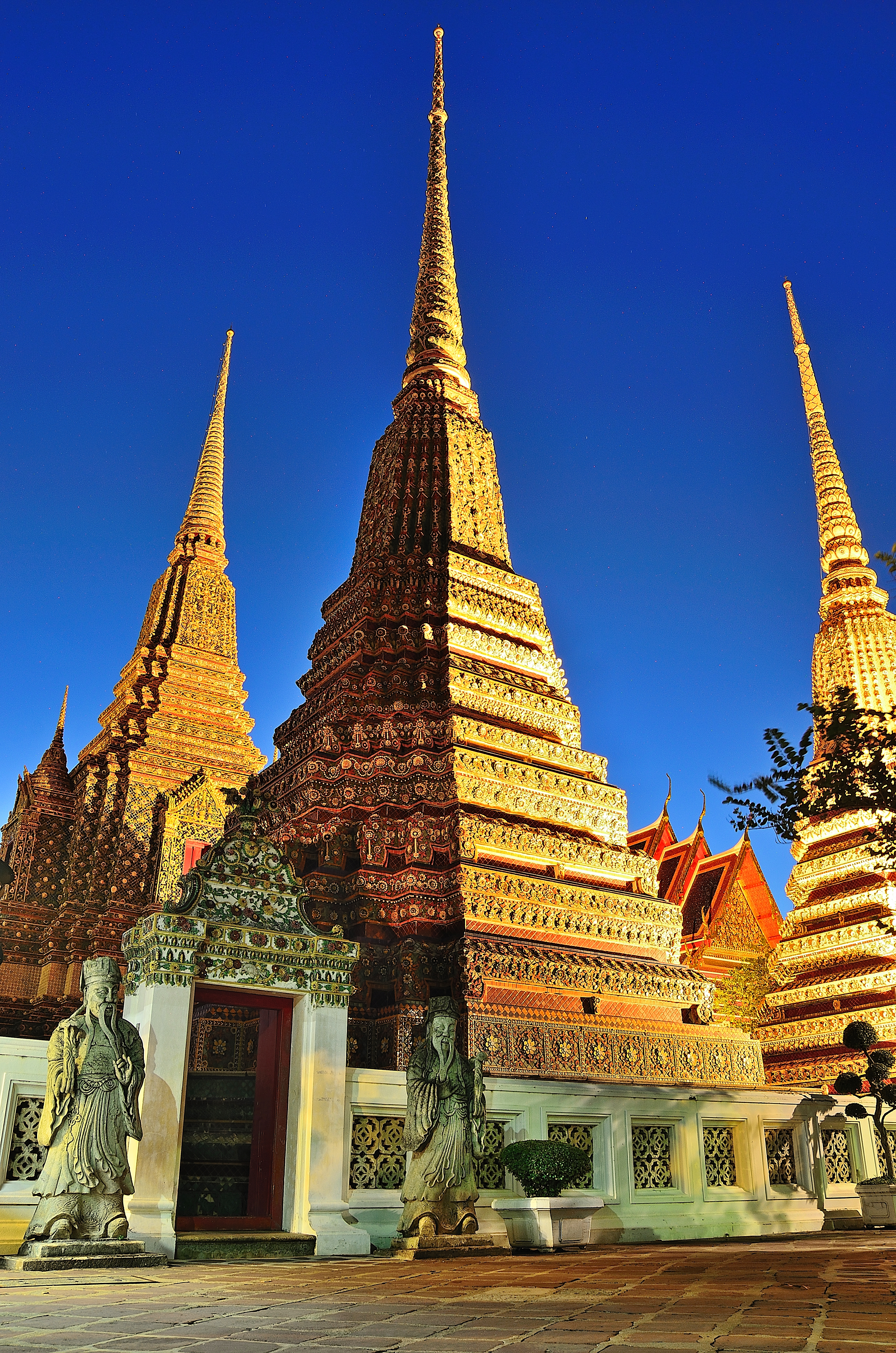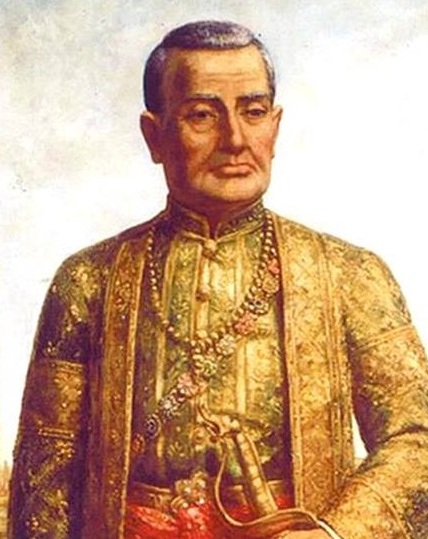|
Prasat (Thai Architecture)
A ''prasat'' ( th, ปราสาท, from Sanskrit: ), or more accurately, ''kudakhan'' (, from Pali/Sanskrit: ) or ''rueanyot'' (), is a Thai architectural form reserved for royal palaces of the monarch or for sacred religious structures. It is a building featuring an ornate roof structure, usually multi-tiered, with one or more spires. The form symbolizes the centre of the universe, which is traditionally associated with the monarch or the Buddha. ''Prasat'' forms are widely used in the buildings of the Grand Palace, and are also found in some Buddhist temples (''wat'') and in the architecture of the temporary crematoria used for royal funerals. Architectural historians have classified ''kudakhan'' into several categories, according to the shape of the spire: ''mondop''-shaped, ''prang''-shaped, ''mongkut''-shaped, and others (including stupa-shaped and '' phra kiao''–shaped, depending on the author). Gallery ''Mondop''-shaped File:Phra Thinang Sutthai Sawan Prasat.jpg, Su ... [...More Info...] [...Related Items...] OR: [Wikipedia] [Google] [Baidu] |
Dusit Maha Prasat, BKK 2
{{Disambiguation ...
Dusit () is the Thai name for Tushita, the fourth heavenly realm in Buddhist cosmology. The name may refer to: * Dusit District, a district of Bangkok *Dusit Palace, namesake of the district *Dusit Subdistrict, Bangkok, in Dusit District * Dusit Subdistrict, Nakhon Si Thammarat, in Tham Phannara District *Dusit International, a Thai hospitality company *Suan Dusit University, sometimes shortened as Dusit, formerly known as Suan Dusit Rajabhat University and part of the Rajabhat University system *Chut Thai Dusit, a dress style of the formal Thai national costume See also * Dusit (name) *Dusit Thani (other) Dusit Thani was a miniature city and micronation project created by King Vajiravudh of Siam. Dusit Thani may also refer to: * Dusit Thani hotel or Dusit Thani Bangkok, a hotel in Bangkok * Dusit Thani Public Company Limited, also known as Dusit I ... [...More Info...] [...Related Items...] OR: [Wikipedia] [Google] [Baidu] |
Dusit Palace
Dusit Palace ( th, พระราชวังดุสิต, RTGS: ''Phra Ratcha Wang Dusit'') is a compound of royal residences in Bangkok, Thailand. Constructed over a large area north of Rattanakosin Island between 1897 and 1901 by King Chulalongkorn (Rama V). The palace, originally called ''Wang Suan Dusit'' or 'Dusit Garden Palace' (วังสวนดุสิต), eventually became the primary (but not official) place of residence of the King of Thailand, including King Chulalongkorn (Rama V), King Vajiravudh (Rama VI), King Prajadhipok (Rama VII), King Bhumibol Adulyadej (Rama IX) and King Vajiralongkorn (Rama X). The palace covers an area of over and is dotted between gardens and lawns with 13 different royal residences. Dusit Palace is bordered by Ratchwithi Road in the north, Sri Ayutthaya Road in the south, Ratchasima Road in the west and U-Thong Nai Road on the east. History Background Since 1782 and the foundation of Bangkok as the capital city of the Kingdo ... [...More Info...] [...Related Items...] OR: [Wikipedia] [Google] [Baidu] |
Pyatthat
Pyatthat ( my, ပြာသာဒ်, ; from Sanskrit ; mnw, တန်ဆံၚ် ; also spelt pyathat) is the name of a multistaged roof, with an odd number of tiers (from three to seven). The pyatthat is commonly incorporated into Burmese Buddhist and royal architecture (e.g., kyaungs, palace buildings, pagodas) and towers above the image of the Buddha or other sacred places (e.g., royal thrones and city gates). Construction The pyatthat is made of successive gabled rectangular roofs in an exaggerated pyramidal shape, with an intervening box-like structure called the ''lebaw'' () between each roof. The pyatthat is crowned with a wooden spire called the ''taing bu'' () or ''kun bu'' () depending on its shape, similar to the hti, an umbrella ornament that crowns Burmese pagodas. The edges of each tier are gold-gilded decorative designs made of metal sheet, with decorative ornaments called ''du yin'' () at the corners (analogous to the Thai '' chofah''). There are three primary ... [...More Info...] [...Related Items...] OR: [Wikipedia] [Google] [Baidu] |
Wat Pho
Wat Pho ( th, วัดโพธิ์, ), also spelled Wat Po, is a Buddhism, Buddhist temple complex in the Phra Nakhon, Phra Nakhon District, Bangkok, Thailand. It is on Rattanakosin Island, directly south of the Grand Palace, Bangkok, Grand Palace. Known also as the Temple of the Reclining Buddha, its official name is Wat Phra Chetuphon Wimon Mangkhalaram Rajwaramahawihan ( th, วัดพระเชตุพนวิมลมังคลารามราชวรมหาวิหาร; ). The more commonly known name, Wat Pho, is a contraction of its older name, ''Wat Photaram'' (; ). The temple is first on the list of six temples in Thailand classed as the highest grade of the first-class royal temples. It is associated with King Rama I who rebuilt the temple complex on an earlier temple site. It became his main temple and is where some of his ashes are enshrined. The temple was later expanded and extensively renovated by Rama III. The temple complex houses the largest ... [...More Info...] [...Related Items...] OR: [Wikipedia] [Google] [Baidu] |
Wat Phichayayatikaram
Wat Phichaya Yatikaram Worawihan, also referred to as Wat Phichai Yat ( th, วัดพิชยญาติการาม, วัดพิชัยญาติ) is a Thai Buddhist temple in Bangkok, regarded as one of the most beautiful and outstanding temples of Bangkok and Thonburi side. The temple is located by the waterside of Khlong Somdet Chao Phraya in Khlong San District near present Wongwian Lek. Wat Phichai Yat was registered to a national ancient monument by the Fine Arts Department in the year 1949. Gallery file:Inside Wat Phichaiyatikaram Templebangkok.jpg, The temple and white stūpas file:Wat Phichaiyatikaram,Bangkok.jpg, Aerial view by nighttime file:Pra Sitharod.jpg, Phra Sittharot file:วัดพิชยญาติการามวรวิหาร.JPG, Monument of Somdet Chao Phraya Borom Maha Phichai Yat the restorer file:Watpichayart.jpg, The ''Prang'' (Khmer-style pagoda) file:วัดพิชยญาติการามวรวิหา ... [...More Info...] [...Related Items...] OR: [Wikipedia] [Google] [Baidu] |
Wat Phra Kaew
Wat Phra Kaew ( th, วัดพระแก้ว, , ), commonly known in English as the Temple of the Emerald Buddha and officially as Wat Phra Si Rattana Satsadaram, is regarded as the most sacred Buddhist temple in Thailand. The complex consists of a number of buildings within the precincts of the Grand Palace in the historical centre of Bangkok. It houses the statue of the Emerald Buddha, which is venerated as the country's palladium. Construction of the temple began in 1783 under the orders of Rama I, the first king of the Chakri dynasty. Since then, each successive king has been personally involved in adding, restoring and embellishing the temple during their reigns as a way of making religious merit and glorifying the dynasty. Many important state and royal ceremonies are held within the temple each year, presided by the king in person and attended by government officials. This makes the temple the nation's preeminent place of worship and a national shrine for the mo ... [...More Info...] [...Related Items...] OR: [Wikipedia] [Google] [Baidu] |
Phra Nakhon Khiri
Phra Nakhon Khiri ( th, อุทยานประวัติศาสตร์พระนครคีรี) is a historical park in Phetchaburi, Thailand on a hill overlooking the city. The name ''Phra Nakhon Khiri'' means 'holy city hill', but locals know it better as ''Khao Wang'', meaning 'hill with palace'. The park consists of three building groups on the three peaks of the 95 m hill. On the western peak is the palace with adjoining structures. On the middle or central peak is a big chedi named ''Phra That Chom Phet''. The eastern peak houses the ''Wat Phra Kaeo'', the royal temple, built in similar fashion to the ''Wat Phra Kaeo'' in Bangkok. The whole complex was built as a summer palace by King Mongkut, with construction finished in 1860. The site was registered as a historical park on 27 August 1979, with two of the palace buildings now housing a branch of the Thai National Museum. Gallery File:Phra Nakhon Khiri historical park 02.JPG File:Khao Wang 003.JPG Fi ... [...More Info...] [...Related Items...] OR: [Wikipedia] [Google] [Baidu] |
Wat Ratchanatdaram
Wat Ratchanatdaram ( th, วัดราชนัดดาราม, ) is a buddhist temple (wat) located at the intersection between Ratchadamnoen Klang and Maha Chai Road, in Phra Nakhon district, Bangkok. Meaning ''Temple of the Royal Niece'', the temple was built to the order of King Nangklao (Rama III) for his granddaughter, Princess Somanass Waddhanawathy in 1846. Loha Prasat Loha Prasat, which means iron castle or iron monastery (โลหะปราสาท), is composed of five towers, of which the outer, middle and the center towers contain large black iron spires. The 37 virtues that are required to reach enlightenment are signified by 37 golden spires. The multi-tiered structure consists of 3 levels, the bottom one has 24 spires, the middle one 12 and the top level has 1 spire. There were two other similar structures which previously existed in the world. Modelled after the earlier ones in India and Anuradhapura Anuradhapura ( si, අනුරාධපු ... [...More Info...] [...Related Items...] OR: [Wikipedia] [Google] [Baidu] |
Bang Pa-in Palace
) , former_names = , alternate_names = , image = Bang Pa-In Royal Palace - Bang Pa-In.jpg , image_alt = , caption = Aisawan Dhiphya-Asana Pavilion , map_type = Thailand , map_alt = , map_caption = , altitude = , architectural_style = , structural_system = , cost = , ren_cost = , client = , owner = , current_tenants = , landlord = , address = Bang Pa-in, Ayutthaya , known_for = , location_country = Thailand , coordinates = , start_date = 1632 , completion_date = , inauguration_date = , renovation_date = , demolition_date = , destruction_date = , dimensions = , antenna_spire = , status = , top_floor = , other_dimensions = , floor_count = , floor_area = ... [...More Info...] [...Related Items...] OR: [Wikipedia] [Google] [Baidu] |
Thai Architecture
The architecture of Thailand ( th, สถาปัตยกรรมไทย) is a major part of the country's cultural legacy and reflects both the challenges of living in Thailand's sometimes extreme climate as well as, historically, the importance of architecture to the Thai people's sense of community and religious beliefs. Influenced by the architectural traditions of many of Thailand's neighbors, it has also developed significant regional variation within its vernacular and religious buildings. Although Siam urged to identify themselves as a modernized state, Western culture and influence was undesirable and inevitable. In an attempt to become distinguished, Thailand's ruling elite gravitated toward selective Modernization to avoid the undesired Western influence. History Dvaravati era (7th–11th century CE) The architecture of Dvaravati appears in the central region of Thailand. It used clay bricks and sometimes laterite. The construction of pagodas had a square base ... [...More Info...] [...Related Items...] OR: [Wikipedia] [Google] [Baidu] |
Mongkut (crown)
Mongkut ( th, มงกุฏ; 18 October 18041 October 1868) was the fourth monarch of Siam (Thailand) under the House of Chakri, titled Rama IV. He ruled from 1851 to 1868. His full title in Thai was ''Phra Bat Somdet Phra Menthora Ramathibodi Sri Sinthara Mahamakut Phra Mongkut Phra Siam Deva Mahamakut Wittaya Maharaj'' (พระบาทสมเด็จพระปรเมนทรรามาธิบดีศรีสินทรมหามงกุฎ พระจอมเกล้าเจ้าอยู่หัว พระสยามเทวมหามกุฏวิทยมหาราช). Outside Thailand, Mongkut is best known as the king in the 1951 musical and 1956 film ''The King and I'', based on the 1946 film '' Anna and the King of Siam''in turn based on a 1944 novel by an American author about Anna Leonowens' years at his court, from 1862 to 1867, drawn from Leonowens’ memoir. Siam first felt the pressure of Western expansionism during Mongkut ... [...More Info...] [...Related Items...] OR: [Wikipedia] [Google] [Baidu] |






